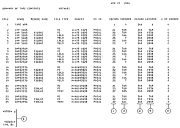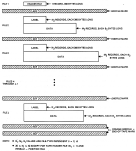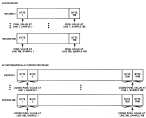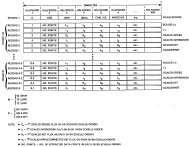Since the information in lines 1-100 of the labels of files associated with a given image is identical, the complete label data are listed only for the first file (RI) of the sequence of files for that image. For successive files associated with that image, lines 6-100 are suppressed, and only lines 1-5 and the file-unique processing-history records in lines 101 et. seq. are printed. Note that this abbreviated format applies only to the printed listings; all label lines are physically present on the magnetic tape.
8.1.4.2 Tape Contents Summary
At the end of the label listings, the labelprint concludes with a tape contents summary sheet which serves to recap the file identifications and verify the physical error status of each record on the tape. Figure 8-2 illustrates a typical tape summary sheet, and Table 8-1 provides an explanatory key. The files pertinent to a particular image are enumerated in consecutive lines, with a space left between images. The information on the number of 360-byte label records may be of particular convenience to users with certain hardware configurations. The error count must be zero on all tapes released to GOs. Figure 8-2:
Tape Contents Summary Sheet
Figure 8-2:
Tape Contents Summary Sheet
8.2 Magnetic Tape File Formats
As is discussed in other sections, each output file generated by IUESIPS consists of a set of label records followed by a set of data records. Schematically, a GO tape consists of series of files as shown in Figure 8-3. Figure 8-3:
Schematic GO Tape Structure
Figure 8-3:
Schematic GO Tape Structure
For the ith file, the number of label records, Ni, the number of data records, Mi, and the length in bytes of each data record, Bi, all depend on the type of data in the file. The detailed label and data formats for each type of file which might appear on GO tapes are given in Sections 8.2.1 and 8.2.2.
8.2.1 LABEL RECORDS
8.2.1.1 Normal Labels
Normal IUESIPS file labels consist of between 20 and 30 physical tape records, although the maximum allowable number of records is 42. Each physical record is 360 bytes in length (one byte = 8 binary bits), being a concatenation of 5 72-byte logical records. A 72-byte logical record corresponds to one line in the labelprint listing described in Section 8.1.4. Thus, lines in the image label are blocked 5 at a time to form 360-byte physical records (blocks) on a tape.Raw image labels are 20 physical records (blocks) long. As the image proceeds through the processing system, additional label information is appended. Since the information added at any given step may or may not fill one or more entire block(s), a continuation character at the end of each logical record is used to flag the end of the label as follows. If any logical record is followed by at least one other, the EBCDIC character "C" is placed in byte no. 72 of that logical record to signify a continuation. The last logical record of the whole label contains the EBCDIC character "L" in byte no. 72. Note that the end-of-label flag need not occur on a block boundary; any logical records which appear after the "L" in the last block are undefined (they generally contain core garbage). The overall label-record structure is shown in Figure 8-4.
As explained in Section
8.1.4,
the label records are in a mixture of EBCDIC
and binary formats. Observers using computers with non-EBCDIC characters
(e.g., ASCII) are reminded that a character format conversion will be required
to display the EBCDIC label portions correctly.
 Figure 8-4:
Standard IUESIPS Label Record Structure
Figure 8-4:
Standard IUESIPS Label Record Structure
8.2.1.2 Nonstandard Labels
Two special types of files have nonstandard labels. (1) The Tape Header file which begins each GO tape has only 1 block, of which only the first logical record is filled; see Section 9. All information is in EBCDIC format. The Tape Header File label has no "size parameters" field (see Section 9) as all other labels do. (Note further that the Tape Header File has no data records.) (2) Reseau-position files generated from calibration images have only several blocks in their labels. Unlike the Tape Header file labels, reseau-position labels do have the standard size parameters in the first logical record, and generally several other logical records are presented containing identification information for the source of the reseau data.8.2.2 DATA RECORDS
The length, number, and format of the records in the data portion of each file depend on the file type and are described below. In all files, the data records are unblocked, i.e., logical record = physical record. Except for reseau-position files, all entries are binary integer quantities, in either one-byte or two-byte format.8.2.2.1 Image Files
8.2.2.1.1 Raw Images
There are 768 physical records, each containing the pixel values along one scan line of the image. Each record is 768 bytes long; each pixel value is represented by one 8-bit byte (range 0-255). See Figure 8-5(a).8.2.2.1.2 Photometrically Corrected Images
There are 768 physical records, each containing the pixel values along one scan line of the image. Each record is 1536 bytes long; each pixel value is represented by two 8-bit bytes, i.e., one halfword binary integer (range +/- 32767, with negatives represented in two's-complement form). See Figure 8-5(b); see also Section 5.3.3 for information on the coding of the halfword values. Figure 8-5:
(a) Data Record Structure for Raw Image File (RI)
Figure 8-5:
(a) Data Record Structure for Raw Image File (RI)
(b) Data Record Structure for Photometrically Corrected Image File (PI)
8.2.2.2 Extracted-Spectral Files
The extracted spectral data are presented in a scaled-integer form. The number of records depends on the dispersion and file type (LBLS, MELO, MEHI), although the overall format is common to all three file types.- All records are 2048 bytes long. Each entry is a two-byte or 16-bit
halfword integer (range 32767, with negatives in two's complement
form), and there are thus 1024 entries per record. The first entry of
each record is a data-record sequence number which begins with 0 for
the first physical record; the second entry is a count of the number
of filled entries for that record.
- The first record (record sequence number 0) is a scale-factor record
containing data pertinent to all following records. The contents and
explanation of this record are given in Table
8-2 .
- The remaining records contain the actual extracted spectral data in
scaled form, arranged in groups of logically associated records.
There is one such group of records associated with every extracted
order (or pseudo-order in the case of low dispersion LBLS data).
- The records within each logical grouping contain the wavelength,
quality flag (epsilon) and flux data for the order in question, on a
point-by-point basis. In every case there is a record giving the
scaled wavelengths Li (see below) of each extracted point, followed by
a record (or records) giving the scaled fluxes Ii
of each extracted
point.
- For LBLS data there is only one scaled flux record per group, repre- senting the gross line-by-line flux for one pseudo-order; see Figure 8-6. Hence there are three records per group, and 55 groups.
 Figure 8-6:
Data Record Structure for Spatially Resolved Low Dispersion Spectral File (LBLS)
Figure 8-6:
Data Record Structure for Spatially Resolved Low Dispersion Spectral File (LBLS)
- For MELO data there are four scaled flux records per group, representing the gross, background, net, and absolutely calibrated net fluxes, respectively; see Figure 8-7. Hence there are six records per group, and there is only one group.
- For MEHI data there are four scaled flux records per group, representing the gross, interorder, net, and ripple-corrected net fluxes, respectively, for one echelle order; see Figure 8-8. Hence there are six records per group. There are 60 groups for SWP, 54 groups for LWR and LWP.
- The scaled-integer fluxes Ii must be converted to actual
floating-point FN values according to the expression
FNi = Ii × J × 2-K
where FNi is the floating-point FN value for the ith extracted point, Ii is the corresponding scaled-integer flux for the ith point, and J and K are scaling constants obtained from the scale-factor record described in Table 8-2. Note that each flux type (gross, background, net and absolute or ripple-corrected net) is scaled separately, although the scaling for each type spans all orders. The flux minima and maxima stored in the scale-factor record along with each J and K set are themselves scaled in the same way as the Ii values on tape. - The scaled wavelengths Li
must be converted to actual floating-point wavelengths in angstroms
(Å), according to the expression
 i =
i =
 o + UNIT × Li
o + UNIT × Li
where i is the floating-point wavelength (Å) for the ith
extracted point, Li is the corresponding scaled-integer
wavelength for the
ith point, UNIT is a scaling factor (0.2 Å in
low dispersion, 0.002 Å in high dispersion), and
i is the floating-point wavelength (Å) for the ith
extracted point, Li is the corresponding scaled-integer
wavelength for the
ith point, UNIT is a scaling factor (0.2 Å in
low dispersion, 0.002 Å in high dispersion), and
 o
is an order-dependent offset wavelength specified in entries 103-202
of the scale-factor record. In low dispersion,
o
is an order-dependent offset wavelength specified in entries 103-202
of the scale-factor record. In low dispersion,
 o= O; in high
dispersion,
o= O; in high
dispersion,
 o is the largest integer less than or equal to the
actual wavelength of the first extracted data point in the order
in question. Bianchi, Northover, and Clavel (1982) point out
that because of the 0.2 Å granularity in low-dispersion
wavelengths decoded from tape, the apparent wavelength interval
between successive extracted points is not precisely uniform,
whereas in fact the extraction is performed at equal
intervals. They suggest that the user linearly interpolate
between the minimum and maximum assigned wavelengths if a
precisely uniform wavelength interval is needed.
o is the largest integer less than or equal to the
actual wavelength of the first extracted data point in the order
in question. Bianchi, Northover, and Clavel (1982) point out
that because of the 0.2 Å granularity in low-dispersion
wavelengths decoded from tape, the apparent wavelength interval
between successive extracted points is not precisely uniform,
whereas in fact the extraction is performed at equal
intervals. They suggest that the user linearly interpolate
between the minimum and maximum assigned wavelengths if a
precisely uniform wavelength interval is needed.
 Figure 8-7:
Data Record Structure for Merged Low Dispersion Spectral File (MELO)
Figure 8-7:
Data Record Structure for Merged Low Dispersion Spectral File (MELO)
 Figure 8-8:
Data Record Structure for Merged High Dispersion Spectral File (MEHI)
Figure 8-8:
Data Record Structure for Merged High Dispersion Spectral File (MEHI)
8.2.2.3 Other Files
8.2.2.3.1 Fine Error Sensor (FES) Images
There are M physical records, each containing the FES pixel values along one scan line of the FES image. Each record is 2M bytes long; each pixel value is represented by two 8-bit bytes (range ± 32767, with negatives in two's- complement form). M is determined by the telescope operations procedures. See Figure 8-9.8.2.2.3.2 Reseau-Position Data Sets
There are four physical records, each of which is 1400 bytes long. The data represented are the precise locations of reseaux output from the program FNDRES. A data set for camera n (1 = LWP, 2 = LWR, 3 = SWP, or 4 = SWR) has blanks in all records except the nth, which contains the line and sample coordinates, in pairs of real numbers for each reseau mark, beginning at the upper left of the camera faceplate and proceeding left to right by rows. Each coordinate is written as a positive fullword (4-byte) floating-point number (R*4). Since each line and sample coordinate pair thus occupies 8 bytes, the number of bytes containing meaningful data in the nth record is 8 times the number of reseau marks identified; remaining bytes out to 1400 are zeroed out. See Figure 8-10 where a camera 3 (SWP) reseau set is illustrated, assuming a total of N reseau marks are identified. Note that N is always less than or equal to 169. Figure 8-9:
Data Record Structure for Fine Error Sensor Image File (FES)
Figure 8-9:
Data Record Structure for Fine Error Sensor Image File (FES)
 Figure 8-10:
Data Record Structure for Reseau-Position Data Set File (RES)
Figure 8-10:
Data Record Structure for Reseau-Position Data Set File (RES)
 Figure 8-1:
Photowrite System Response Function (Desired Photographic Density vs. DN).
Figure 8-1:
Photowrite System Response Function (Desired Photographic Density vs. DN).